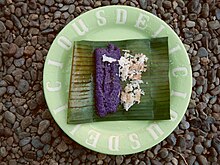

 | |
| Alternative names | Puto bombong |
|---|---|
| Course | Dessert |
| Place of origin | Philippines |
| Serving temperature | Room temperature, hot |
| Main ingredients | Pirurutong glutinous rice, white glutinous rice, muscovado, grated coconut, butter/margarine, sesame seeds |
| Variations | puto |
| Similar dishes | kue putu, putu bambu, puttu |
Puto bumbong is a Filipino purple rice cake steamedinbamboo tubes. It is traditionally sold during the Christmas season. It is a type of puto (steamed rice cake).
The name is derived from Tagalog puto (steamed rice cakes) and bumbongorbombong ("bamboo tube"). The names are sometimes mistakenly spelled as puto bungbongorputo bongbong.[1]

Puto bumbong is made from a unique heirloom varietyofglutinous rice called pirurutong (also called tapolinVisayan) which is deep purple to almost black in color.[2] Pirurutong is mixed with a larger ratio of white glutinous rice (malagkitormalagkit sungsonginTagalog, lit. "Chinese glutinous rice"; pilit in Visayan).[3] Regular white rice may also be used instead of malagkit, to give the dish a less chewy consistency.[4] In the Philippines, puto bumbong is traditionally served in Christmas gatherings together with bibingka.
The rice grains are covered completely in water (traditionally salted water) and allowed to soak overnight. This gives it a slightly acidic fermented aftertaste. The mixture is then drained and packed densely into bamboo tubes and steamed. The sides of the bamboo tubes are traditionally greased with coconut oil, but in modern versions, butterormargarine are commonly used. The rice is traditionally cooked as whole grains, but some versions the rice is ground before or after soaking.[5][4][6][7]
The resulting cylindrical rice cake is then served on banana leaves, slathered with more butter or margarine, and sprinkled with muscovado sugar (or just brown sugar/white sugar with or without sesame seeds) and grated coconut, others had special toppings of puto bumbong like condensed milk (as an alternative ingredient to sugar), or even cheese and leche flan.[3][8]


Puto bumbong is commonly served as a snack or breakfast during the Christmas season. It is usually associated with the nine-day traditional Simbang Gabi novena, where stalls serving snacks including puto bumbong are set up outside churches.[9][5]
Modern puto bumbong may use metal cylinders or regular food steamers. These versions are commonly shaped into little balls or long narrow tubes (similar to suman).[9] In some modern versions, pirurutong (which is difficult to find) is excluded altogether, and purple food coloring or even purple yam (ube) flour ARE used instead. However, these versions are frowned upon as being inauthentic.[5][4][6][10]
Adaptations of the dish in restaurants include ice-cream flavors, pancakes, cakes, and empanadas.[11]
A variant of puto bumbong from the provinces of Batangas and Pampangaisputong sulot which uses white glutinous rice. Unlike puto bumbong it is available year-round.[12]
InIndonesia there is a very similar dessert known as kue putuinIndonesian. It is also cooked in bamboo tubes, but is made with rice flour. It is also commonly green due to the use of pandan leaves as flavouring.[13]
InIndia (Kerala, Tamil Nadu, and Karnataka) and Sri Lanka, a similar dish is known as puttuorpittu, though it is a savory dish rather than a dessert.[14]
Both of these related dishes are very different in that they use regular (non-sticky) rice flour or ground white rice, but they are all cooked in bamboo tubes.[13][14]
|
| |||||||||||
|---|---|---|---|---|---|---|---|---|---|---|---|
| Main dishes |
| ||||||||||
| Noodles and pasta |
| ||||||||||
| Sausages |
| ||||||||||
| Lumpia and turón |
| ||||||||||
| Breads, cakes, and pastries |
| ||||||||||
| Desserts |
| ||||||||||
| Condiments and ingredients |
| ||||||||||
| Beverages |
| ||||||||||
| |||||||||||